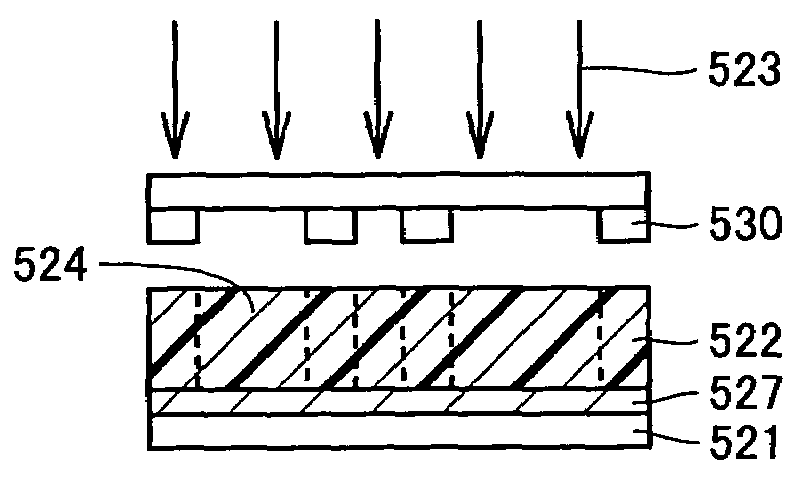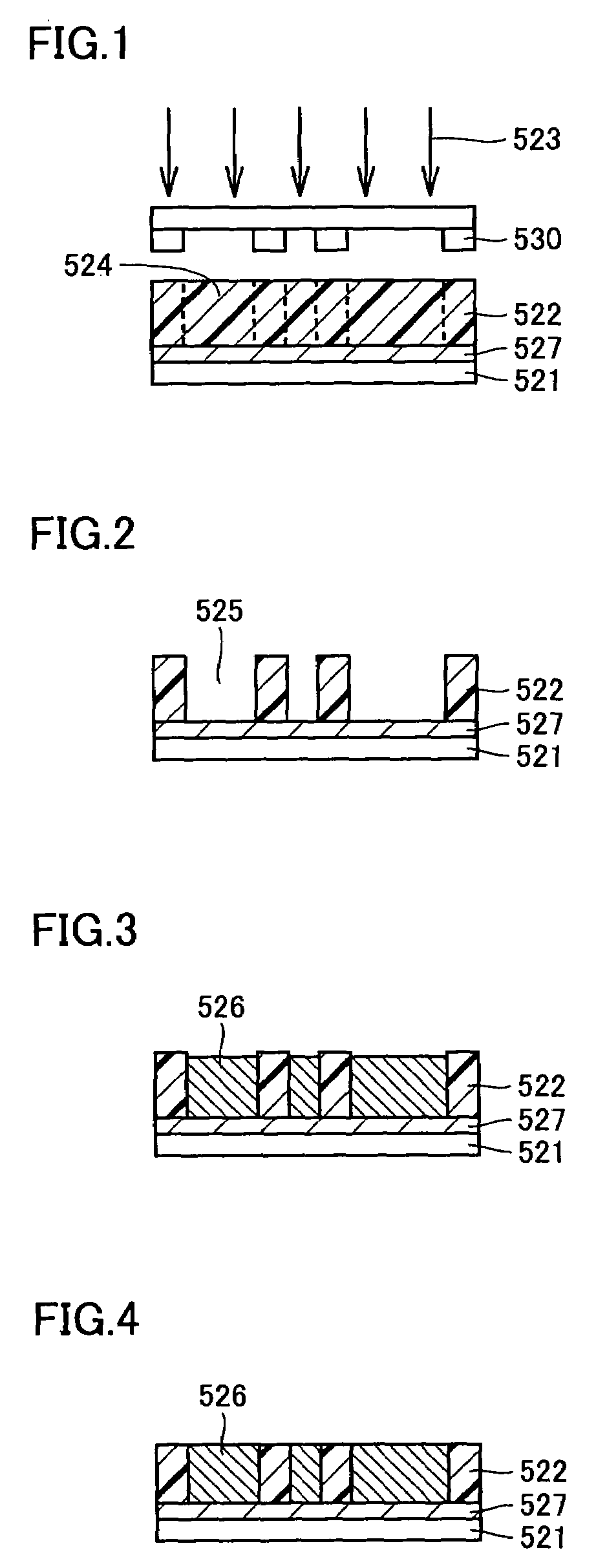Contact probe, method of manufacturing the contact probe, and device and method for inspection
a technology of contact probe and manufacturing method, which is applied in the direction of contact probe manufacturing, semiconductor/solid-state device testing/measurement, instruments, etc., can solve the problems of point contact not being achieved, contact pressure not being increased above a prescribed level, and the contact probe itself being weaker, etc., to achieve reliable conduction, reliable conduction, and reliable conduction
- Summary
- Abstract
- Description
- Claims
- Application Information
AI Technical Summary
Benefits of technology
Problems solved by technology
Method used
Image
Examples
first embodiment
[0070]Referring to FIGS. 1–9, a method of manufacturing a contact probe of a first embodiment based on the first invention will be described.
[0071]First, a resist film 522 is formed on an upper surface of a conductive substrate 521. A metal substrate including SUS, Cu, Al, or the like, an Si substrate, a glass substrate, or the like can be used as substrate 521. It is noted that in the case of an Si substrate, a glass substrate, or the like, a metal layer of Ti, Al, Cu, Ni, Mo, or a combination thereof is formed in advance on the upper surface of substrate 521 by sputtering to serve as an underlying conductive layer 527. Alternatively, even in the case of using a metal substrate, the underlying conductive layer may be formed by sputtering or the like on the metal substrate as necessary. In the following, description will be made with reference to the figures, assuming that underlying conductive layer 527 is present.
[0072]As shown in FIG. 1, using a mask 530, the surface of resist fi...
second embodiment
[0081]Referring to FIGS. 13–21, 8 and 9, a method of manufacturing a contact probe in a second embodiment based on the first invention will be described.
[0082]As shown in FIG. 13, using a metal die 532 having convexity as the shape of the contact probe, a resin die 533 is formed by injection molding. As a result, a resin die 533 having concavity as the shape of the contact probe results. This resin die 533 is polished so that the concave portion is penetrated in order to fabricate a resin pattern frame 534 as shown in FIG. 15. As shown in FIG. 16, substrate 521 having underlying conductive layer 527 formed on the upper surface thereof is prepared, as in the first embodiment, and resin pattern frame 534 is affixed on the upper surface thereof. As described in the first embodiment, underlying conductive layer 527 may be omitted if substrate 521 is a metal substrate. The concave portion may be penetrated after resin die 533 is affixed to substrate 521 (not shown). As shown in FIG. 17, ...
third embodiment
[0086]Referring to FIGS. 1–4, 22, 23, and 7–9, a method of manufacturing a contact probe in a third embodiment based on the first invention will be described.
[0087]The steps shown in FIGS. 1–4 are the same as described in the first embodiment. As shown in FIG. 4, the upper surface of metal layer 526 is ground or polished to attain a uniform thickness as desired, in the present embodiment, followed by ashing to remove resist film 522, as shown in FIG. 22. As shown in FIG. 23, electrical discharge machining is performed using an electrical discharge machining electrode 542. Electrical discharge machining electrode 542 is an electrode having a tip end formed into a conical shape or a V-shape. In this electrical discharge machining, a machined surface is formed obliquely with respect to the part serving as the tip end portion of the contact probe.
[0088]In the example shown in FIG. 23, electrical discharge machining is performed with metal layer 526 being affixed on substrate 521, althou...
PUM
| Property | Measurement | Unit |
|---|---|---|
| thickness | aaaaa | aaaaa |
| length | aaaaa | aaaaa |
| thickness | aaaaa | aaaaa |
Abstract
Description
Claims
Application Information
 Login to View More
Login to View More - R&D
- Intellectual Property
- Life Sciences
- Materials
- Tech Scout
- Unparalleled Data Quality
- Higher Quality Content
- 60% Fewer Hallucinations
Browse by: Latest US Patents, China's latest patents, Technical Efficacy Thesaurus, Application Domain, Technology Topic, Popular Technical Reports.
© 2025 PatSnap. All rights reserved.Legal|Privacy policy|Modern Slavery Act Transparency Statement|Sitemap|About US| Contact US: help@patsnap.com



